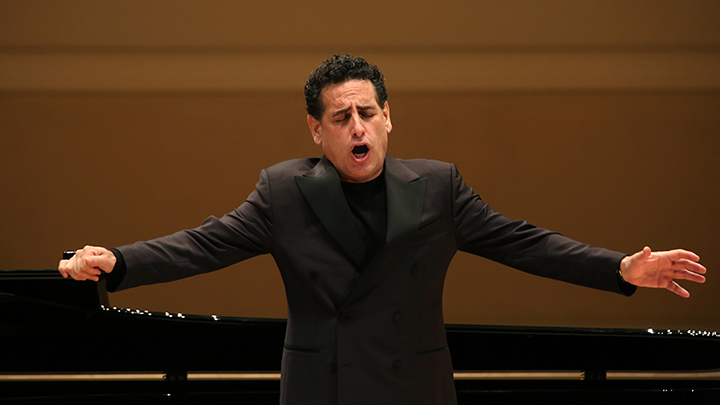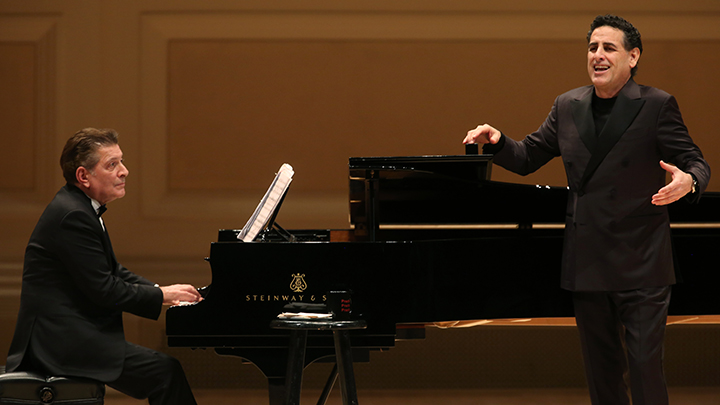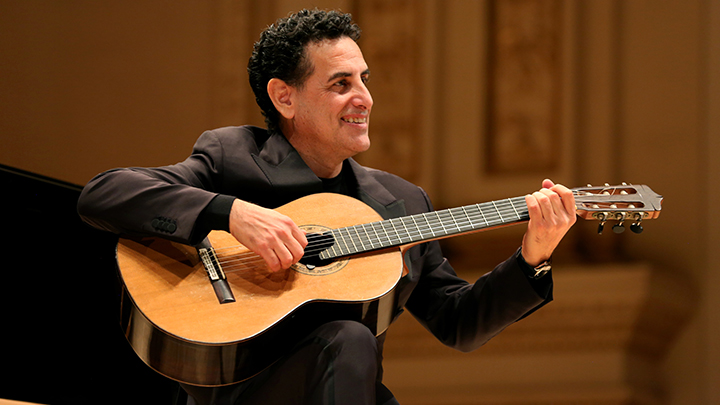
He has not appeared in our fair city since, though the Metropolitan Opera is desperately in need of box office stars. Flórez was scheduled to appear in recital at Carnegie Hall in January 2023, but a bout of COVID-19 caused him to remain on the other side of the Atlantic. Despite a lingering head cold which almost made him cancel a second time, the Peruvian superstar boarded a plane and appeared on November 29 at Carnegie Hall in front of a packed house, to the delight of his many fans. He was assisted by the stylish and attentive accompanist Vincenzo Scalera who also performed solo piano pieces by Rossini, Verdi and Puccini to give our tenor some brief respite. We desperately need some star vocalism and charisma these days and his public showed up (several brandishing Peruvian flags) and Flórez delivered, majorly.
Looking and sounding remarkably trim, fresh and youthful at 50 years of age, the tenor stuck to what he loves and does best: bel canto of the 19th century primo ottocento type that established his fame moving chronologically to later 19thcentury Italian and French opera arias from his newer repertory. He started with two 18th century bel canto arie antiche. Neapolitan songs, South American pop and folk material and one sole zarzuela aria arrived for the encores. The programming and the style of singing were very old school – and the better for it.
The majority of the program were opera arias, and since he has been absent from our opera stages for half a decade, we were happy to get a glimpse of roles he hasn’t performed here (Roméo, the Duke of Mantua, Prince Idreno in Rossini’sSemiramide). He seems to be content to be a lyric tenor, as the late Alfredo Kraus did, so he didn’t stretch his voice in arias from La Forza del Destino or Carmen, heaven forbid! (We have all seen sadly where that leads from Di Stefano to Carreras to Villazon et al.).
What he established in his first selection “O del mio dolce ardor” from Gluck’s Paride ed Elena was musical sensitivity allied to a command of the technical and artistic facets of classic old school bel canto – beautifully sustained and shaped line supported on an endless supply of breath, precisely executed and musically appropriate ornamentation and textual expression aided by dynamic coloration and shading that brings the music and word together as one entity.
Flórez further revealed his bel canto credentials with two contrasting selections from Alessandro Parisotti’s collection of Arie Antiche – Caccini’s caressing “Amarilli, mia bella” and Carissimi’s triumphant, defiant “Vittoria, mio core!” One piece shows an ardent lover longing for his beloved to believe in his love and the other glad to no longer care about his fickle lover. It was lovely to hear subtly deployed grace notes, turns and variations in second verses all executed precisely with keen attention to musical structure, expression and style. Meanwhile, Flórez lavished an expressive mezza voce to enhance or contrast the musical phrasing.
He finished up the first half with the composer who established his career and fame, Gioachino Rossini. We started with two songs from the composer’s late post-operatic salon pieces “Péchés de vieillesse” – “L’esule” (the Exile) and “La Lontananza” (Separation). Again, stylish phrasing with caressing half-voice phrasing was contrasted with ardent forte high note climaxes which elicited enthusiastic applause from the house. The lyrical cavatina “Deh! tu m’assisti amore” from Il signor Bruschino showed the star tenor in his youthful opera buffa young lover mode while Idreno’s multi-part scena “La speranza più soave” from Rossini’s Semiramide revealed the more heroic bravura coloratura and virtuoso display that he is famous for.
After intermission, it was all opera arias all the time. We were treated to Donizetti and Matteo Salvi’s attempting to be Donizetti. “Linda! Si Ritirò … Se tanto in ira agli uomini” from Donizetti’s opera semiseria Linda di Chamounix showed the tenor hero balancing grief and anger having to renounce his low-born lover due to social pressure. Flórez rose eloquently to the final anguished phrases.
Il duca d’Alba was a work that was abandoned when the French impresario went bankrupt. The librettist Eugène Scribe recycled the libretto for Verdi’s Les Vêpres Siciliennes (I Vespri Siciliani) and Donizetti recycled major parts of the score for La Favorite including the tenor romance “Ange si pur”. In 1881-1882, a Donizetti student Matteo Salvi unveiled a revision/completion of the dead composer’s unfinished grand opera Il duca d’Alba in Rome. The aria “Inosservato penetrava … Angelo casto e bel” from La duca d’Alba is a replacement aria composed by Salvi when he found that “Ange si pur” had become famous as “Spirto gentil” in La Favorita. Here the tenor (Henri/Arrigo) becomes Marcello observing his beloved Amelia praying in church and wishes her peace and happiness and that he alone should suffer. Flórez was both ardently virile and softly imploring in this melodic showpiece. The Salvi aria has been recorded beautifully by Italian tenors from Enrico Caruso to Luciano Pavarotti.
We were on more familiar ground with “Questa o quella” from Verdi’s warhorse Rigoletto, an opera Flórez has performed in Europe. Early and middle Verdi are still beholden to Italian bel canto in vocal composition and musical structure and there is a lot of late Donizetti in Rigoletto. The singers Verdi was composing for were also bel canto specialists who developed their vocal techniques on Rossini, Bellini and Donizetti. They could trill, turn a roulade and execute a messa di voce. It was nice to hear a Duke that didn’t bulldoze or bawl his way through this “light as a feather in the wind” aria but tossed it off lightly with elegance and style.
We segued into the French part of the program with Verdi in his Parisian mode – “L’émir auprès de lui m’appelle … Je veux encore entendre” from Jérusalem. Verdi’s 1847 Jérusalem is a grand opera refitting of his early I Lombardi (1843) to a new French libretto for the Paris Opéra. This aria is Oronte’s cavatina “La mia letizia infondere” from I Lombardifitted out with a different opening recitative and a smart, well-set French translation. Oronte becomes Gaston, a French crusader (a role created for the famous tenor Gilbert-Louis Duprez) held prisoner in Palestine.
The component of nasality in Flórez’s vocal apparatus and technique is quite the asset in singing in French: the tone is forward, narrow and bright as it should be. Pronunciation is good, if not totally idiomatic, but well above the non-francophone tenor average. What was lacking throughout the program which was especially apparent in the French arias was a lack of voix mixte vocal production in the upper register. When Flórez went high, he went loud. All the high notes were firm but rather opaque and lacking spin. (Age, the lingering cold or just his basic approach to singing opera may contribute to this – the notes were definitely there).
Flórez can sing softly and seductively in his middle and upper middle registers as he did to great effect in Mylio’s aubade “Puisqu’on ne peut flechir … Vainement, ma bien-aimée” from Edouard Lalo’s Le Roi d’Ys. He was a radiantly youthful and ardent Roméo in Charles Gounod’s “L’amour, l’amour! … Ah! lève-toi, soleil” from his Roméo et Juliette. The final high B-flat was attacked loud and confidently held.
Cultivating softer high head tones as a rule rather than an exception would make the French repertory even more congenial to Flórez (who also sings the title roles in Faust and Werther). One wishes there was an alternate cast to the upcoming revival of Roméo et Juliette next Spring at the Met so we could compare Flórez and Benjamin Bernheim.
One thing I have to give Flórez credit for is that the pressed, forced and strident vocalism we have sometimes heard from him in his newer heavier lyric repertory in broadcasts and videos was not in evidence last night. I think the cold made him more conservative. The only evidence of the cold was blowing his nose between solos, drinking water often from a Carnegie Hall mug and a very rare tentative vocal attack. Flórez showed a firm sense of his vocal strengths and limitations and kept to “never louder than lovely” approach. We need lovely more than we need loud these days.
His final piece of the official program was early Puccini “Ecco la casa Dio … Torna ai felici dì” from the one-acter Le Villi. Here we heard more angst and occasionally he sounded like he needed to martial his vocal forces carefully but succeeded.
There were, by my count, seven encores. The Peruvian element in the audience became quite vocal at this point, calling out requests which the tenor shrugged off bemusedly. He started out with a persuasive Neapolitan favorite “Core ‘ngrato” by the Italo-American composing team of Cardillo/Cordiferro with expert accompaniment by Scalera.
Then after promising that he would bring out his guitar for Peruvian songs, a kick stand and chair were brought out. Flórez appeared and sang two songs by Chabuca Garda, a Peruvian singer and composer whose repertory was a specialty of Ruben Flórez, the tenor’s late father who was a well-regarded pop singer in Peru and whose repertory Juan Diego has known since his early childhood. The songs were “José Antonio,” sometimes also known as “Caballo de paso” about a wild horse whose human rider dies in the mountains but is not abandoned by his faithful equine friend and the more familiar “Flor de canela”. Flórez seemed to be communing with his guitar and the huge auditorium seemed to turn into a small Peruvian cabaret room and the audience was drawn close to him.
The familiar “El día que me quieres” of Carlos Gardel showed the tenor totally in his element – if you are going to cross over this is how it is done. “Cucurrucucú paloma” by Tomás Méndez was bifurcated by premature applause but when resumed featured a soft heady “bocca chiusa” medium high note sustained over several bars of guitar accompaniment seeming to last for five minutes without a breath taken. Hypnotic.
The evening ended with a zarzuela selection accompanied by Scalera on piano: “No puede ser” from La tabernera del puerto by Sorozábal delivered with fervent ardor and command.
One heard throughout how vocal graces developed in the early Italian baroque opera were adopted by Rossini and his bel canto brethren, were expanded by Verdi and influenced the vocal writing of the French grand opera. You also saw a connection between early Italian baroque opera and the Italian folk songs which developed into the Neapolitan song. The Neapolitan songs showed parallels with Spanish song and South American pop. All exemplified by Flórez’s command of bel canto singing – whether in opera, baroque, zarzuela, Neapolitan song or Peruvian popular music.
My friend commented that Flórez is not only an artist but an entertainer and there was never one boring moment. More recitals (especially star recitals) need to achieve that. Loving your material is the place to start – his hands seemed to caress the musical phrases as well as his voice. There was a lot of love of music on that stage and it communicated to the audience over the footlights and was transmitted back. Glad to see those evenings still can happen.
Photos: Steve J. Sherman




























Comments